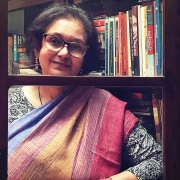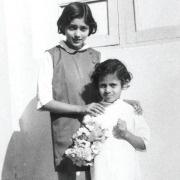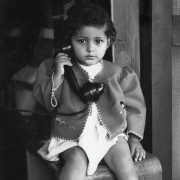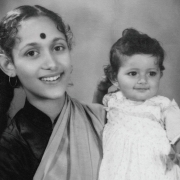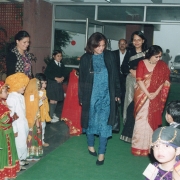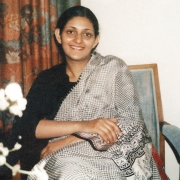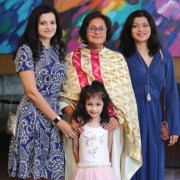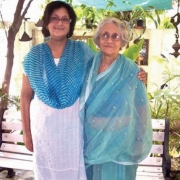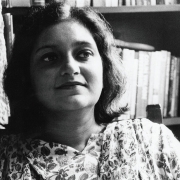
People
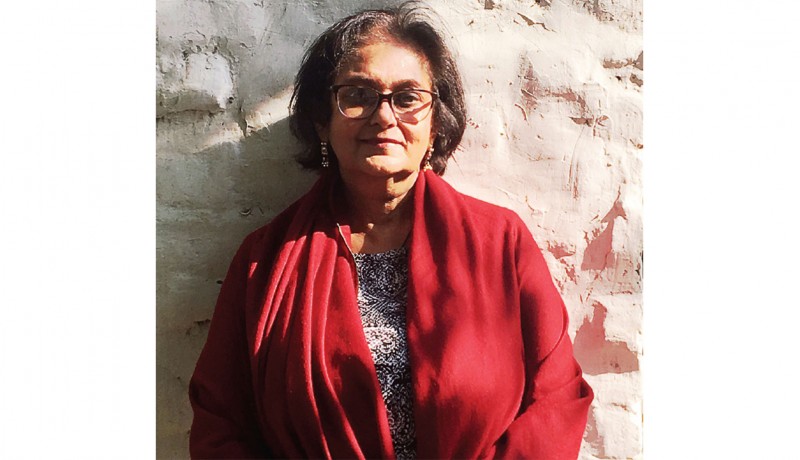
Writer, publisher and festival director Namita Gokhale is at the forefront of a literary revival in the country, says Srirekha Pillai
She burst upon the literary scene in 1984 with a rather unconventional but sparkling social satire, Paro: Dreams of Passion, which swirled around the cocktail circuit of Delhi, capturing the shenanigans of Page 3 celebs, long before the term was even coined. Here was a woman writer who wrote unabashedly about sex and spoke in a language that resonated with desi readers, far removed from the oh-so-propah language of Indo-Anglian writing in those days.
Reminiscing about the furore and outrage her book caused, writer-publisher Namita Gokhale wrote in an exclusive column in Harmony Celebrate Age in August 2014, “I was completely unprepared…I had been brought up, at least by default, to say what I thought, and had never bothered too much about other people’s opinions of me.” The book, though, had a dream debut oversees with literary agency Curtis Brown picking it up within two days of Gokhale’s arrival in London, and Chatto & Windus signing her on. One of England’s oldest literary periodicals, The London Magazine, called Paro “a magnificent creation”.
Individualistic and forthright, Gokhale has followed—and spoken—her heart right from her early days. Even as a student of English literature at Delhi University’s Jesus and Mary College, she refused to attend classes on ‘Chaucer and Old English’, preferring ‘Modern Indian Literature in Hindi’, an option that remained only on paper, with the college offering absolutely no classes for it. The college debarred her from taking the examination. It was around this time that she met, fell in love and married Rajiv Gokhale, son of H R Gokhale, law minister in Indira Gandhi’s cabinet. Later, in her classic witty manner, Gokhale remarked, “When I got married, the nuns were appalled. They believed I had succumbed to lust and said special prayers for me.”
Born in Lucknow in 1956, Gokhale was brought up by her irrepressible grandmother Shakuntala Pande—niece of freedom fighter Pandit Govind Ballabh Pant—and free-spirited aunts (among them, acclaimed Hindi writer Shivani), in an extended joint family in Nainital. Little wonder then, that the sights and sounds of Kumaon and formidable women form an intrinsic part of Gokhale’s narratives. She paid tribute to her doughty grandmother and aunts through their oral biographies in Mountain Echoes. Gokhale herself has been through hell and back. A cancer survivor, she lost her husband at 39. Not surprisingly, love, loss and death are recurrent motifs in her books.
Remarkably, Gokhale has transcended her role as a litterateur to emerge as a bridge between Indian writing in English and regional languages. Yatra Books, of which she is co-founder and director, publishes books in regional languages, besides translating bestselling English authors in Hindi, Marathi, Odia, Bangla, Telugu, Gujarati and Kannada. Her successful book-based show Kitaabnaama on Doordarshan was also an attempt to connect different literary traditions and voices.
Recently, Gokhale became the first recipient of the Centenary National Award for Literature presented by the Assam Sahitya Sabha for “her literary contributions as well as her service to the nation in supporting and showcasing literary talents and creating a literary environment in the country”. Meanwhile, her book Things to Leave Behind is on the long list for the 2018 Dublin Literary Award.
As the curtain rises on the 2018 edition of the Jaipur Literary Festival (JLF), Delhi-based Gokhale, who is also founder and co-director of what is eulogised as the ‘greatest literary show on earth’, admits, “It is like a flowing river, a stream of creative energy … seeking and finding its own path.” Much like her!
EXCERPTS FROM AN INTERVIEW
It is often said writing throws up new insights about the self and society. Could you share your journey of discovery?
Each of my books has been in the nature of a personal quest, a journey of discovery. Fictional narratives cover either the path of one’s own life and experiences, or a flight of imagination into the life one may have lived. Both are powerful triggers to self-discovery.
You’ve been a catalyst for fostering a creative environment in the subcontinent through writing, publishing and organising literary festivals. Was it planned?
Nothing in my life was planned. I have been very lucky in that so many of the things I set upon in a spirit of enthusiasm and genuine curiosity rather than ambition have succeeded at different levels. I do strategise and think ahead, but life is so full of unexpected twists and turns that I have learned to go with the flow, carefully observing the terrain and the signs on the ground.
As the publisher of Super, you chronicled Bollywood during its golden age.
All of us who worked on Super were very young and many of my colleagues in the magazine have remained good friends, especially [editor] Rauf Ahmed. Those were days of laughter and creativity, and I learned to respect the power of popular culture, and of the Bollywood dream machine. The memories… they are too many to share here! But the excitement of producing sharp copy and dazzling design, month after month, was a real high.
You’ve worked extensively with mythology. What is the appeal of mythology to modern readers?
In India, myth is a subject of vital contemporary interest. The great epics, the Mahabharata and the Ramayana, are reinterpreted generation after generation, and they form a matrix most Indians can relate to. I have written The Book of Shiva and The Puffin Mahabharata for young and first-time readers. The story of Sita’s second exile, her abandonment while she was pregnant by her husband Rama, and the general and unquestioning acceptance of this, baffled and infuriated me. I co-edited an anthology, In Search of Sita, with Malashri Lal, which questioned the justice of this through essays, stories and poetry. The book, in turn, inspired others and the general attitude to the subject did change to a large extent. I have also recently written another book for young readers called Lost in Time: Ghatotkacha and the Game of Illusions.
In the author’s note to Paro: Dreams of Passion you quoted your father, “I hope you have been discreet, child.” What was the reaction of the rest of your immediate and extended family to this unconventional debut?
Well, I was always considered unconventional and my immediate and extended family were used to my springing surprises at them. All my family, including my mother-in-law, were extraordinarily supportive. I cherish and respect the support they gave, have always given, me.
After Paro, there was a significant gap of 10 years before Gods, Graves and Grandmother. Did the success of Paro place undue pressure on you?
I wrote a novel after Paro, which was only published much later. That was A Himalayan Love Story, the first of the Himalayan trilogy. Paro was a hard act to follow, and readers and publishers perhaps expected me to follow such a successful formula. However, as I explained, each novel is a personal quest for me, and I was searching for a new narrative.
The Book of Shadows is written in the voice of a ghost. I believe you’ve had some psychic experiences while writing it.
I wanted to experiment with a new voice and the thought of a spirit, suspended in time, observing human activity, sometimes getting drawn into it, and yet not a part of it, intrigued me. The ghost literally got under my skin. I had recently lost my husband, and was absorbed in the contemplation of death, of other unknown dimensions. A large part of the novel was in a sense ‘channelled’, it was a form of unconscious writing. Our subconscious minds are more knowing, than our surface understanding.
Yes, there were strange things happening around then. I repeatedly lost the manuscript from my computer—it would simply disappear—and computer experts were puzzled and unable to explain quite where the problem lay. There would be just a line from within the novel—not the first or opening line—that would appear on screen, declaring, ‘I hide in shadows, I lurk in corners’. It was as though there was a ghost in the machine. There’s a lot more to the tale, and maybe someday I will write a novel about writing that novel!
Shakuntala: The Play of Memory deals with past-life memories. Have you had a brush with past-life remembrances?
After I had completed Paro, I knew this was the novel that waited to be written. There were a series of images that persisted, that didn’t go away. A river with sunlight reflecting on the waves. A man by the river, on a horse. A house on a hill, which I recognised, where I knew I had once lived. These were inexplicable memories, perhaps from another life, and they needed to be made sense of, to be strung together in a story. But that was just the spine of the novel—it was the craft of fiction that helped structure it and bring it to life.
When you write for young readers as in Mahabharata or the recent Lost in Time, who serves as your sounding board?
I write for myself, for the child within. I do watch out for vocabulary and for a simple flow of ideas. I try very hard not to write down for young readers, or in any way condescend to them. And I have received extremely perceptive editorial support from Puffin India for both the books.
Of all the books you have written, which has been your favourite creative journey?
It’s difficult to choose any one book—each has been a unique creative journey. Writing a novel is never much fun, at least not for me. It’s a self-imposed and addictive form of rarefied torture, which takes over everyday life in alarming ways.
Have there been instances where certain characters have stayed on in your head long after a book has seen the light of day?
I have enjoyed writing all the 16 books I have worked on, though there is always a point midway where it becomes a heavy load to carry all those lives and characters in one’s mind. Sometimes they take on a life of their own, as with the larger-than-life figure of Paro in my debut novel, or the whimsical, eccentric and utterly charming Tillotama in the recent Things to Leave Behind.
For every writer, the creative process is unique. For you, how does a story take shape?
At first there are some images. Then, some lines of text emerge. Then, the outlines of a shape, a structure, a story. And yet, all the time, I feel the story already exists somewhere, in another dimension, that I have to transcribe, to pluck from the air and give voice to.
Can you share the story behind the genesis of JLF?
I had worked on the first ever Neemrana International Festival of Indian Literature. After that, William Dalrymple contacted me, requested me to help put a new festival together in Jaipur for Faith Singh and the Virasat team. Then, later, Sanjoy Roy and Teamworks entered the picture. So many people contributed to the journey in their different ways, but the festival always had a life of its own. It was, and is, like a flowing river, a stream of creative energy, bigger than all of us, seeking and finding its own path. It has been a transformative experience and a great privilege to be associated with this extraordinary festival.
With so many new writers, is it an exciting time for Indian writing in English?
This is an exciting time for Indian writing—in English and in Indian languages. The dynamics between the various languages, the realities of our changing times, are all leading to a literary moment. India is now the second largest English publishing market, and there is a large internal market, a huge number of aspirational readers. There are also the new opportunities to self-publish, the platforms and outreach made possible by technology.
Incidentally, you also curated Kitaabnama: Books and Beyond on Doordarshan. How different was the experience?
I enjoyed working with Doordarshan and it has the most unexpected pool of talent, as well as an outreach unparalleled by other channels anywhere. With Kitaabnama: Books and Beyond, I tried to create a multilingual platform where English, Hindi, Marathi, Bangla, Odia writers, and others from across the 22 Indian languages, could be presented in readings and conversations to a pan-Indian audience. It was incredibly successful and we have a legacy of a hundred programmes accessible on YouTube and Facebook.
However, it ended badly. A notorious person from within the organisation, who fancies himself a poet, harassed and insulted me because I hadn’t invited him to the Jaipur festival. He recently subjected a friend, a famous Hindi woman writer, to the same sort of public defamation. So I decided to move on.
You wrote Paro in longhand and then typed it out. Are you still a pen and paper person?
Yes, I write the first draft with a favourite pen or well-sharpened pencil, in double spacing, in a series of numbered notebooks, which I then type out for the first edit. Sometimes my assistant Rita Peter types out this first draft for me, for she can decipher and make sense of my chaotic scribbles.
Can you share your biggest literary influence?
The Mahabharata, with its stories within stories, and its cast of characters that remain true to human nature despite the passage of thousands of years, has been my greatest literary influence. I came to discover this great epic only late in life, but it has taught me so much.
How can women writers help empower women?
Women writers can give strength to their readers by invoking strength rather than victimhood in their narratives.
How tech-friendly are you? Are you comfortable with the Kindle?
I am reasonably tech-friendly but everything changes so fast and my learning curve is rather slow. I love physical books, I need to hold and feel and smell them, but I’m comfortable reading in electronic formats when I must.
Are we becoming an increasingly intolerant society?
Yes, we are becoming an ugly, communal, racist, parochial, even more patriarchal society. In dysfunctional times, it’s easier for humans to hate than to trust. But I’m an optimist and I believe the cycle will change and harmony and equilibrium will emerge.
Your works, particularly the Himalayan trilogy—A Himalayan Love Story, The Book of Shadows and Things to Leave Behind—and Mountain Echoes reflect a proud Kumaoni. How has Kumaon helped shape your personality and literary style?
The Himalayas are the tallest and youngest mountains in the world. Mountain people everywhere are proud and individualistic; they get strength from the terrain. My Kumaoni identity remains an essential part of me, and the landscape and people of Uttarakhand form a recurring motif in my work.
You grew up in a large family comprising grandmother and aunts. How did that influence and inform you as an individual?
My grandmother Shakuntala Pande was an unusually beautiful, intelligent and self-willed person. She gave me love and nurture, as did my mother. I have a large extended family, from both the Kumaoni side and my late husband’s Marathi family. It’s a joy and privilege to grow up in a joint family, and to live in one. My daughters, my sons-in-law, my lovely granddaughter mean a lot to me.
You got married when you were just 18. How did you meet your husband Rajiv Gokhale?
I met him when I was 17 and he was 20. He was my cousin’s friend. I loved him deeply and learned a lot from him.
Please tell us about your family.
My elder daughter Meru Gokhale is editor-in-chief, literary publishing, at Penguin Random House. She is married to writer and historian Patrick French. My younger daughter Shivani Sibal, who holds all our lives together, is married to lawyer Akhil Sibal. Their daughter Anina has two generations of grandmothers: my mother Neerja Pant, who is her ‘Badi Nani’, and her ‘Choti Nani’, which is me.
What kept you going through the hard times?
I take life as it comes. The hard times and the heartbreak have, in time, yielded joy and understanding.
Do you consider writing therapeutic?
Writing is an essential part of who I am. It’s tiring and not therapeutic or anything quite so complicated, but it is how I try to make sense of things, and to search patterns amidst the everyday chaos.
When you look back at your personal journey, what have been the defining moments?
I don’t know. Sometimes it’s the small things, the intangibles, the accidents, and the random, that shape our lives.
Besides literature, what gives you joy?
I love to be lazy, to sleep and dream and hang around. It’s a luxury I don’t get enough of.
What does ageing mean to you?
The passage of years does give perspective on how little, and how much, everything matters. Yes, there is perhaps a precarious wisdom that comes with age.
What is your health mantra?
I’m afraid I don’t have a health mantra. I eat and drink as I please, and love laddoo and fried food. I swim in summer and avoid medication, though I’m a homeopathy addict. I pray a lot. And try to smile through it all.
BOOKMARK
- Paro: Dreams of Passion, 1984
- Gods, Graves, and Grandmother, 1994
- A Himalayan Love Story, 1996
- Mountain Echoes: Reminiscences of Kumaoni Women, 1998
- The Book of Shadows, 1999
- The Book of Shiva, 1999
- Shakuntala: The Play of Memory, 2005
- The Puffin Mahabharata, 2009
- In Search of Sita (co-edited with Malashri Lal), 2009
- The Habit of Love, 2012
- Priya: In Incredible Indyaa, 2013
- Travelling In, Travelling Out (edited), 2014
- Himalaya: Adventures, Meditations, Life (co-edited with Ruskin Bond), 2016
- Things to Leave Behind, 2016
- Lost in Time: Ghatotkacha and the Game of Illusions, 2017
- The Himalayan Arc: East of South East, 2018
WORDS MATTER
Gokhale is not just the founder and co-director of the high-profile Jaipur Literature Festival (from 2006). She is engaged with other festivals as well.
- Founder and co-director—Mountain Echoes, the Bhutan Festival of Literature, Art & Culture (from 2009)
- Founder—Crime Writer’s Festival (from 2015)
- Conceptualised—International Festival of Indian Literature at Neemrana; 2002
- Conceptualised—The Africa Asia Literary Conference; 2006
Photo: Srishti Jha Archival images courtesy: Namita Gokhale Featured in Harmony — Celebrate Age Magazine January 2018
you may also like to read
-
For the love of Sanskrit
During her 60s, if you had told Sushila A that she would be securing a doctorate in Sanskrit in the….
-
Style sensation
Meet Instagram star Moon Lin Cocking a snook at ageism, this nonagenarian Taiwanese woman is slaying street fashion like….
-
Beauty and her beast
Meet Instagram star Linda Rodin Most beauty and style influencers on Instagram hope to launch their beauty line someday…..
-
Cooking up a storm!
Meet Instagram star Shanthi Ramachandran In today’s web-fuelled world, you can now get recipes for your favourite dishes at….



